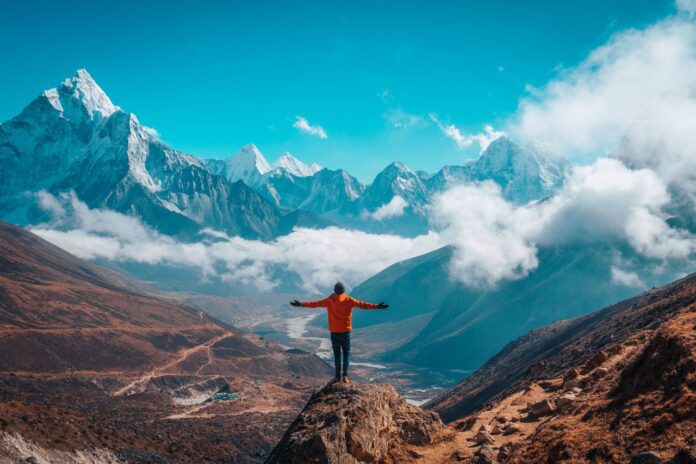Nestled in the breathtaking landscapes of the Himalayas lies a trek that is revered by adventurers and nature enthusiasts alike—the Everest Base Camp trek. This iconic journey takes trekkers through awe-inspiring vistas, diverse terrains, and a rich cultural tapestry, culminating at the base of the world’s highest peak, Mount Everest.
Overview:
The Everest Base Camp trek typically begins in Lukla, a small town in the Khumbu region of Nepal. From Lukla, trekkers embark on a multi-day expedition through a variety of terrains, including lush forests, suspension bridges straddling roaring rivers, and rugged mountain trails. The journey not only offers a physical challenge but also an immersive cultural experience as it winds through Sherpa villages, allowing trekkers to interact with the local communities and witness their traditions firsthand.
Best time to visit
The best time to embark on the Everest Base Camp trek largely depends on weather conditions, visibility, and trail accessibility. Generally, two primary seasons are recommended for the trek:
Spring (March to May):
– Weather: The weather during spring is generally stable and mild, with warmer temperatures and longer daylight hours.
– Visibility: Clear skies offer excellent visibility of the stunning Himalayan peaks, providing breathtaking views along the trekking route.
– Flora: The region comes to life with rhododendron blooms and lush vegetation, adding vibrant colors to the landscape.
– Crowds: This season tends to be popular, so expect more trekkers on the trails and in accommodations.
Autumn (September to November):
– Weather: Autumn brings dry and stable weather, with clear skies and moderate temperatures, making it another ideal time for trekking.
– Visibility: Excellent visibility of the mountains and landscapes due to the clear weather conditions.
– Trail Conditions: Trails are well-defined, and the terrain is relatively dry, making trekking more comfortable.
– Festivals: Occurrence of festivals like Dashain and Tihar in Nepal, offering a chance to experience local culture and traditions.
– Crowds: Like spring, autumn is a popular time, so expect moderate to high trekker traffic.
Both spring and autumn offer favorable weather conditions for the Everest Base Camp trek, allowing for clear views of the Himalayas and providing comfortable trekking conditions. These seasons are preferred by most trekkers due to the stable weather and better visibility, but personal preferences regarding crowd levels and temperature should also be considered when planning the trip.
Route and Highlights:
– Lukla to Namche Bazaar: The trek starts with a flight to Lukla followed by a hike to Phakding and eventually Namche Bazaar, a bustling Sherpa town and a hub for trekkers. The trail offers stunning views of the Dudh Koshi River and introduces trekkers to the Sherpa way of life.
– Acclimatization in Namche Bazaar: Acclimatization days are crucial to adjust to the high altitude. Trekkers often explore nearby areas like Khumjung and Syangboche, visit monasteries, and soak in the panoramic views of Everest and its neighboring peaks.
– Tengboche Monastery: En route to Everest Base Camp, the trail passes through Tengboche, known for its beautiful monastery with a backdrop of Mount Everest. The spiritual aura and serene surroundings make it a memorable stop for trekkers.
– Dingboche and Acclimatization: The trek continues to Dingboche, where another acclimatization day helps prepare for higher altitudes. Trekkers can hike to Nagarjun Hill for spectacular views or explore the area.
– Lobuche and Gorak Shep: As the journey progresses, trekkers reach Lobuche and Gorak Shep, the final settlement before Everest Base Camp. Gorak Shep also serves as the base for the hike to Kala Patthar, offering one of the most stunning views of Everest and the Khumbu Glacier.
– Everest Base Camp: The ultimate destination of the trek, Everest Base Camp, is an experience unlike any other. The sight of the Khumbu Icefall and the towering peak of Everest is a testament to the raw beauty and magnificence of nature.
Challenges and Preparations:
The EBC trek is physically demanding and requires adequate preparation. Altitude sickness is a real concern due to the high elevation, so gradual acclimatization and staying hydrated are crucial. Proper gear, including sturdy trekking boots, warm clothing, and a good sleeping bag, is essential for the varying weather conditions.
Cultural Immersion:
One of the most enriching aspects of the EBC trek is the interaction with the Sherpa community. Their hospitality, rich cultural heritage, and warmth add depth to the journey. Trekkers often get a glimpse into their traditions, visit monasteries, and learn about their way of life.
Tips
Certainly! Here are some valuable tips for a successful Everest Base Camp trek:
Physical Preparation:
– Training: Engage in cardiovascular exercises, endurance training, and leg strength workouts to prepare for the trek’s physical demands.
– Gradual Acclimatization: Ascend gradually to allow your body to acclimatize to the altitude, reducing the risk of altitude sickness.
Gear and Packing:
– Proper Gear: Invest in quality trekking gear, including well-fitted trekking boots, layered clothing for varying temperatures, a good quality sleeping bag, and a reliable backpack.
– Essentials: Carry essential items like water purification tablets, a first-aid kit, sunscreen, lip balm, and a headlamp or flashlight.
Hydration and Nutrition:
– Hydration: Stay hydrated by drinking plenty of water throughout the trek, even if you don’t feel thirsty, to combat the effects of high altitude.
– Nutrition: Consume a balanced diet with carbohydrates for energy and high-altitude snacks like nuts and dried fruits. Avoid heavy or greasy foods that might be difficult to digest.
Pace Yourself:
– Slow and Steady: Trek at a comfortable pace, allowing time for acclimatization and enjoyment of the scenery. Avoid rushing to higher altitudes, which can lead to altitude sickness.
– Rest and Acclimatization Days: Utilize acclimatization days to rest and explore nearby areas, aiding in altitude adjustment.
Health and Safety:
– Altitude Sickness Awareness: Familiarize yourself with symptoms of altitude sickness and communicate any discomfort to your guide or fellow trekkers.
– Follow Safety Guidelines: Respect local customs, stay on designated trails, and listen to your guide’s advice for a safe and enjoyable experience.
– Insurance: Consider travel insurance that covers trekking at high altitudes and emergency evacuation if needed.
Hiring a Guide/Porter:
– Guide/Porter: Consider hiring a local guide or porter to assist with navigation, carry luggage, and provide valuable insights into the region’s culture and terrain.
Conclusion:
Trekking to Everest Base Camp is not just about reaching a destination; it’s a transformative journey filled with natural wonders, personal challenges, and cultural experiences. The sense of achievement upon reaching the base of the world’s highest peak, combined with the memories of breathtaking landscapes and cultural encounters, makes this trek an unforgettable adventure.
The Everest Base Camp trek is a testament to the allure of the Himalayas, drawing adventurers from around the globe to experience the majesty of Mount Everest and the surrounding peaks. For those seeking an adventure that combines physical exertion with cultural immersion, this iconic trek stands as a beacon, inviting explorers to embark on a life-changing expedition to the roof of the world.













